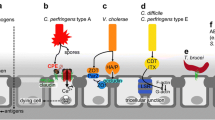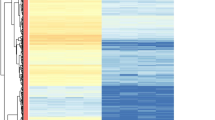Abstract
The number of patients with uterine endometrial carcinoma, the cause of which involves sex hormones, has recently been growing rapidly because of increases in life expectancy and obesity. Tight junction proteins claudin-3 and −4 are receptors of Clostridium perfringens enterotoxin (CPE) and increase during endometrial carcinogenesis. In the present study of normal human endometrial epithelial (HEE) cells and the uterus cancer cell line Sawano, we investigate changes in the expression of tight junction proteins including claudin-3 and −4, the fence and barrier functions of the tight junction and the cytotoxic effects of CPE by sex hormones. In primary cultured HEE cells, treatment with progesterone (P4) but not estradiol (E2), induced claudin-1, −3, −4 and −7 and occludin, together with the downregulation of the barrier function but not the fence function. In Sawano cells, claudin-3 and −4 were upregulated by E2 but not by P4, together with a disruption of both the barrier and fence function. In primary cultured HEE cells, claudin-3 and −4 were localized at the apicalmost regions (tight junction areas) and no cytotoxicity of CPE was observed. In Sawano cells, claudin-3 and −4 were found not only in the apicalmost regions but also at the basolateral membrane and the cytotoxicity of CPE was enhanced by E2. Thus, tight junctions are physiological regulated by sex hormones in normal HEE cells during the menstrual cycle suggesting that safer and more effective therapeutic methods targeting claudins in uterine cancer can be developed.








Similar content being viewed by others
References
Bray F, Dos Santos Silva I, Moller H, Weiderpass E (2005) Endometrial cancer incidence trends in Europe: underlying determinants and prospects for prevention. Cancer Epidemiol Biomarkers Prev 14:1132–1142
Buck VU, Windoffer R, Leube RE, Classen-Linke I (2012) Redistribution of adhering junctions in human endometrial epithelial cells during the implantation window of the menstrual cycle. Histochem Cell Biol 137:777–790
Camussi G, Turello E, Bussolino F, Baglioni C (1991) Tumor necrosis factor alters cytoskeletal organization and barrier function of endothelial cells. Int Arch Allergy Appl Immunol 96:84–91
Cereijido M, Valdés J, Shoshani L, Contreras RG (1998) Role of tight junctions in establishing and maintaining cell polarity. Annu Rev Physiol 60:161–177
Dellinger TH, Planutis K, Tewari KS, Holcombe RF (2012) Role of canonical Wnt signaling in endometrial carcinogenesis. Expert Rev Anticancer Ther 12:51–62
Diaz J, Aranda E, Henriquez S, Quezada M, Espinoza E, Bravo ML, Oliva B, Lange S, Villalon M, Jones M, Brosens JJ, Kato S, Cuello MA, Knutson TP, Lange CA, Leyton L, Owen GI (2012) Progesterone promotes focal adhesion formation and migration in breast cancer cells through induction of protease-activated receptor-1. J Endocrinol 214:165–175
Duncan ME, Seagroatt V, Goldacre MJ (2012) Cancer of the body of the uterus: trends in mortality and incidence in England, 1985–2008. BJOG 119:333–339
Duong LM, Wilson RJ, Ajani UA, Singh SD, Eheman CR (2011) Trends in endometrial cancer incidence rates in the United States, 1999–2006. J Womens Health (Larchmt) 20:1157–1163
Evans T, Sany O, Pearmain P, Ganesan R, Blann A, Sundar S (2011) Differential trends in the rising incidence of endometrial cancer by type: data from a UK population-based registry from 1994 to 2006. Br J Cancer 104:1505–1510
Feng YZ, Shiozawa T, Miyamoto T, Kashima H, Kurai M, Suzuki A, Ying-Song J, Konishi I (2007) Overexpression of hedgehog signaling molecules and its involvement in the proliferation of endometrial carcinoma cells. Clin Cancer Res 13:1389–1398
Gadducci A, Tana R, Cosio S, Fanucchi A, Genazzani AR (2008) Molecular target therapies in endometrial cancer: from the basic research to the clinic. Gynecol Endocrinol 24:239–249
Gumbiner BM (1993) Breaking through the tight junction barrier. J Cell Biol 123:1631–1633
Iwanaga S, Inokuchi T, Notohara A, Higashi R, Murakami M, Kato T (1985) Alterations in tight junctions of human endometrial epithelial cells during normal menstrual cycle-freeze-fracture electron microscopic study. Nihon Sanka Fujinka Gakkai Zasshi 37:2847–2852
Key TJ, Pike MC (1988) The dose-effect relationship between “unopposed” oestrogens and endometrial mitotic rate: its central role in explaining and predicting endometrial cancer risk. Br J Cancer 57:205–212
Kojima T, Murata M, Yamamoto T, Lan M, Imamura M, Son S, Takano K, Yamaguchi H, Ito T, Tanaka S, Chiba H, Hirata K, Sawada N (2009) Tight junction proteins and signal transduction pathways in hepatocytes. Histol Histopathol 24:1463–1472
Lessey BA (1998) Endometrial integrins and the establishment of uterine receptivity. Hum Reprod 13:247–261
Liao X, Siu MK, Au CW, Chan QK, Chan HY, Wong ES, Ip PP, Ngan HY, Cheung AN (2009) Aberrant activation of hedgehog signaling pathway contributes to endometrial carcinogenesis through β-catenin. Mod Pathol 22:839–847
McClane BA, Chakrabarti G (2004) New insights into the cytotoxic mechanisms of Clostridium perfringens enterotoxin. Anaerobe 10:107–114
Mineta K, Yamamoto Y, Yamazaki Y, Tanaka H, Tada Y, Saito K, Tamura A, Igarashi M, Endo T, Takeuchi K, Tsukita S (2011) Predicted expansion of the claudin multigene family. FEBS Lett 585:606–612
Ogawa M, Kojima T, Someya M, Nomura K, Takasawa A, Murata M, Tanaka S, Saito T, Sawada N (2012) Epidermal growth factor modulates claudins and tight junctional functions in ovarian cancer cell lines. Histochem Cell Biol 138:323–338
Pan XY, Wang B, Che YC, Weng ZP, Dai HY, Peng W (2007) Expression of claudin-3 and claudin-4 in normal, hyperplastic, and malignant endometrial tissue. Int J Gynecol Cancer 17:233–241
Parkin DM (2011) 10. Cancers attributable to exposure to hormones in the UK in 2010. Br J Cancer 105:S42–S48
Pinton P, Braicu C, Nougayrede JP, Laffitte J, Taranu I, Oswald IP (2010) Deoxynivalenol impairs porcine intestinal barrier function and decreases the protein expression of claudin-4 through a mitogen-activated protein kinase-dependent mechanism. J Nutr 140:1956–1962
Santin AD, Bellone S, Marizzoni M, Palmieri M, Siegel ER, McKenney JK, Hennings L, Comper F, Bandiera E, Pecorelli S (2007) Overexpression of claudin-3 and claudin-4 receptors in uterine serous papillary carcinoma: novel targets for a type-specific therapy using Clostridium perfringens enterotoxin (CPE). Cancer 109:1312–1322
Schneeberger EE, Lynch RD (1992) Structure, function, and regulation of cellular tight junctions. Am J Physiol 262:L647–L661
Szabó I, Kiss A, Schaff Z, Sobel G (2009) Claudins as diagnostic and prognostic markers in gynecological cancer. Histol Histopathol 24:1607–1615
Thie M, Fuchs P, Butz S, Sieckmann F, Hoschützky H, Kemler R, Denker HW (1996) Adhesiveness of the apical surface of uterine epithelial cells: the role of junctional complex integrity. Eur J Cell Biol 70:221–232
Tokunaga Y, Kojima T, Osanai M, Murata M, Chiba H, Tobioka H, Sawada N (2007) A novel monoclonal antibody against the second extracellular loop of occludin disrupts epithelial cell polarity. J Histochem Cytochem 55:735–744
Tulac S, Nayak NR, Kao LC, Van Waes M, Huang J, Lobo S, Germeyer A, Lessey BA, Taylor RN, Suchanek E, Giudice LC (2003) Identification, characterization, and regulation of the canonical Wnt signaling pathway in human endometrium. J Clin Endocrinol Metab 88:3860–3866
van Meer G, Gumbiner B, Simons K (1986) The tight junction does not allow lipid molecules to diffuse from one epithelial cell to the next. Nature 322:639–641
Villavicencio A, Aguilar G, Argüello G, Dünner C, Gabler F, Soto E, Gaete F, Peñaloza P, Celis M, Rojas C (2010) The effect of overweight and obesity on proliferation and activation of AKT and ERK in human endometria. Gynecol Oncol 117:96–102
Wang Y, van der Zee M, Fodde R, Blok LJ (2010) Wnt/Β-catenin and sex hormone signaling in endometrial homeostasis and cancer. Oncotarget 1:674–684
Winkler L, Gehring C, Wenzel A, Müller SL, Piehl C, Krause G, Blasig IE, Piontek J (2009) Molecular determinants of the interaction between Clostridium perfringens enterotoxin fragments and claudin-3. J Biol Chem 284:18863–18872
Yamaguchi H, Kojima T, Ito T, Kyuno D, Kimura Y, Imamura M, Hirata K, Sawada N (2011) Effects of Clostridium perfringens enterotoxin via claudin-4 on normal human pancreatic duct epithelial cells and cancer cells. Cell Mol Biol Lett 16:385–397
Zhou C, Gehrig PA, Whang YE, Boggess JF (2003) Rapamycin inhibits telomerase activity by decreasing the hTERT mRNA level in endometrial cancer cells. Mol Cancer Ther 2:789–795
Acknowledgments
This work was supported by the Ministry of Education, Culture, Sports Science, and Technology and the Ministry of Health, Labour, and Welfare of Japan.
Conflicts of interest
The authors declare no conflicts of interest.
Author information
Authors and Affiliations
Corresponding author
Additional information
This work was supported by the Ministry of Education, Culture, Sports Science, and Technology and the Ministry of Health, Labour, and Welfare of Japan.
The authors declare no conflicts of interest.
Rights and permissions
About this article
Cite this article
Someya, M., Kojima, T., Ogawa, M. et al. Regulation of tight junctions by sex hormones in normal human endometrial epithelial cells and uterus cancer cell line Sawano. Cell Tissue Res 354, 481–494 (2013). https://doi.org/10.1007/s00441-013-1676-9
Received:
Accepted:
Published:
Issue Date:
DOI: https://doi.org/10.1007/s00441-013-1676-9




